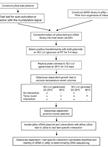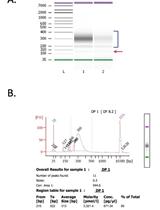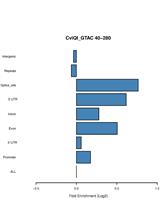- EN - English
- CN - 中文
A Molecular Cloning and Sanger Sequencing-based Protocol for Detecting Site-specific DNA Methylation
一种基于分子克隆和Sanger测序的位点特异性DNA甲基化检测方案
(*contributed equally to this work) 发布: 2022年05月05日第12卷第9期 DOI: 10.21769/BioProtoc.4408 浏览次数: 3472
评审: Amanda M. RoehrkasseRama Reddy GoluguriAnonymous reviewer(s)
Abstract
DNA methylation is a conserved chemical modification, by which methyl groups are added to the cytosine of DNA molecules. Methylation can influence gene expression without changing the sequence of a particular gene. This epigenetic effect is an intriguing phenomenon that has puzzled biologists for years. By probing the temporal and spatial patterns of DNA methylation in genomes, it is possible to learn about the biological role of cytosine methylation, as well as its involvement in gene regulation and transposon silencing. Advances in whole-genome sequencing have led to the widespread adoption of methods that examine genome-wide patterns of DNA methylation. Achieving sufficient sequencing depth in these types of experiments is costly, particularly for pilot studies in organisms with large genome sizes, or incomplete reference genomes. To overcome this issue, assays to determine site-specific DNA methylation can be used. Although often used, these assays are rarely described in detail. Here, we describe a pipeline that applies traditional TA cloning, Sanger sequencing, and online tools to examine DNA methylation. We provide an example of how to use this protocol to examine the pattern of DNA methylation at a specific transposable element in maize.
Keywords: Epigenetics (表观遗传学)Background
DNA methylation is a conserved chemical modification at the 5’ position in the deoxyribose ring of cytosine that is catalyzed by methyltransferases (Figure 2A and Schultz et al., 2012). In plants, DNA methylation occurs in three sequence contexts: CG, CHG, and CHH, where H represents A, T, or C (Zhang et al., 2018). DNA methylation plays an important role in regulating both genes and transposable elements (TEs) (Schultz et al., 2012; Zhang et al., 2018; Guo et al., 2021). Using a maize MuDR reporter system to study TE silencing, we have demonstrated that DNA methylation at a terminal inverted region (TIR) in one of the MuDR elements, mudrA, is associated with silencing (Woodhouse et al., 2006; Guo et al., 2021).
Bisulfite sequencing involves bisulfite treatment of genomic DNA, resulting in the conversion of unmethylated cytosines into uracil, while methylated cytosines remain unchanged. After treatment, the region of interest is amplified, cloned, and sequenced. Investigating DNA methylation at a gene or a TE requires high-quality genomic DNA, and the conversion of unmethylated cytosines into uracil, while retaining methylated cytosines using sodium bisulfite treatment (Gruntman et al., 2008; Zhang et al., 2018). After this treatment, the region of interest is amplified via polymerase chain reaction (PCR), which is followed by TA-cloning and Sanger sequencing (Foerster, 2010). Because PCR amplification of the converted cytosines will replace uracil with thymine, determining the methylation profile at a region of interest can be achieved by comparing the sequence of the bisulfite-treated DNA with that of untreated DNA sequences (Gruntman et al., 2008). To minimize the noise created by incomplete conversion of unmethylated cytosine to uracil, examining DNA methylation using an internal control gene, and assaying multiple individual colonies of PCR products are needed.
Here, we provide a case study with step-by-step procedures, to examine the pattern of DNA methylation at a silenced MuDR element in maize, which is a well-documented system to validate our protocol. We described a site-specific DNA methylation pipeline, using traditional TA cloning and Sanger sequencing and provide procedures for sample preparation, treatment, cloning work, and data analysis. We highlight the applicability of this traditional DNA methylation pipeline as an inexpensive method for pilot studies, important for decision-making, or for use when an organism’s genome is not fully sequenced. Additionally, this pipeline describes the basis of molecular cloning and epigenetic analysis, and how it can be used as a method for teaching.
Materials and Reagents
Eppendorf tubes (Dot Scientific, catalog number: RA1700-GMT)
Glass beads (MO-SCI, catalog number: GL0191B4/38-53)
Axygen 96-well PCR Microplates (Fisher Scientific, catalog number: 14-222-326)
Tissue Culture Treated Petri Dishes (dot scientific, catalog number: 667621)
Competent E. coli cells (Invitrogen, catalog number: 18265017)
Minimal MuDR line (Damon Lisch lab, Purdue University)
Ethylenediaminetetraacetic acid (EDTA) (Fisher Scientific, catalog number: BP2482100)
Sodium chloride (NaCl) (Fisher Scientific, catalog number: BP358-1)
Sodium dodecyl sulfate (SDS) (Fisher Scientific, catalog number: 28312)
Potassium acetate (Fisher Scientific, catalog number: A16321.36)
Isopropanol (Fisher Scientific, catalog number: 040983.M1)
100% Ethanol (Fisher Scientific, catalog number: T038181000)
DNA loading dye 10× (NEB, catalog number: 10816015)
2× PCR Master Mix (Syd Labs, catalog number: MB067-EQ2G-L)
EpiMark Hot Start Taq DNA Polymerase (NEB, catalog number: M0490S)
Bisulfite conversion kit (ZYMO RESEARCH, catalog number: D5005)
Lysogeny broth (LB) medium (Sigma-Aldrich, catalog number: L2897)
T4 ligase (NEB, catalog number: M0202S)
TA cloning vector (Fisher Scientific, catalog number: K1231)
RNase A (Fisher Scientific, catalog number: EN0531)
8-strip PCR tubes and Caps (dot scientific, catalog number: 503-8PCR-A)
Zymoclean Gel DNA recovery Kits (Zymo catalog number: D4007)
ZymoPURE Plasmid Miniprep Kit (Zymo catalog number: D4210)
Equipment
Pipettes (Fisher Scientific, catalog number: EPPR4331)
Microcentrifuge (Fisher Scientific, catalog number: 5424)
Incubator (VWR, catalog number: 13259-36)
Qubit fluorometer (Fisher Scientific, catalog number: Qubit 2.0)
Gel electrophoresis system (NeoSCI, catalog number: 55-1094)
Low speed orbital shaker (Corning LSE, catalog number: 6780-FP)
PCR machine (Bio-Rad, catalog number: 1861096)
Procedure
文章信息
版权信息
© 2022 The Authors; exclusive licensee Bio-protocol LLC.
如何引用
Guo, W., Cannon, A. and Lisch, D. (2022). A Molecular Cloning and Sanger Sequencing-based Protocol for Detecting Site-specific DNA Methylation. Bio-protocol 12(9): e4408. DOI: 10.21769/BioProtoc.4408.
分类
系统生物学 > 表观基因组学 > DNA 甲基化
微生物学 > 微生物遗传学 > DNA
分子生物学 > DNA
您对这篇实验方法有问题吗?
在此处发布您的问题,我们将邀请本文作者来回答。同时,我们会将您的问题发布到Bio-protocol Exchange,以便寻求社区成员的帮助。
Share
Bluesky
X
Copy link












